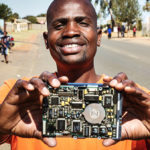Created in 1947, the Doomsday Clock is an internationally recognized concept that conveys the impact of dangerous technologies on our society. Each year, scientists assess these threats and adjust the clock accordingly, moving the minute hand closer or further to midnight. Originally set to seven minutes before midnight, the clock is now closer than it has been in over 20 years; just three minutes from midnight. Why?
Up until 2007, nuclear war was at the top of the list. But recently, climate change, biotechnologies, and the vulnerability created by billions of connections to the Internet have become real threats to society.
That can be quite depressing, but the good news is, we have the power to make a difference. It’s those same connections and technologies which will allow us to move the clock back and speed the pace of change around the world.
We live in an age of digitization, where connected technologies can monitor everything from our heart rates to the energy consumption of the lights in our homes. With these connections come dizzying amounts of data, data we can use to solve real-world problems like the concentration of carbon dioxide in the atmosphere, global unemployment, and worldwide hunger.
Through mobile phones, sensors, and other networked technologies, we can both monitor these issues and use the data to create real change. Many of our nonprofit partners, like Water For People and Living Goods, are already doing so in underserved communities.
The numbers are staggering, but so are the opportunities we have to confront them. It will take all of us —organizations, businesses, and individuals. At the core, we will need a new generation of global problem solvers; people who not only have the knowledge and skills to thrive in a connected world, but also the desire to become agents of social change.
Do we hide or do we step up?
Learn more about Global Problem Solvers at csr.cisco.com/gps


Good blog post.With the connected world we face lot of challenges along with many more benefits to the people.Companies like Cisco can help the skilled work force to tackle the challenges cropping up while using the latest innovative technologies like IOT.
We step up Harbrinder! And I agree that the answer lies in digitizing and connecting our world, but it has to be secured or else the data could move the clock closer to midnight.
Sean, totally agree, security is going to be of paramount importance.
Awesome Harbrinder. But with IOT, security would be of paramount importance.
We set up, we have to…